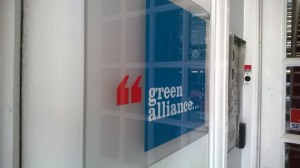Emerging from the underground and into the buzz of people that is Victoria station at 9 am, I did not know what to expect from the day. Spotting a familiar looking piece of scaffolding, I let out a sigh of relief – at least I was walking in the right direction. Indeed, it was the same construction site I had been circling around for ages a few months earlier when making my way to the office of Green Alliance for my interview. Finding that white door tucked next to a screaming red cafe proved to be a much simpler task the second time around, and I was happy to tick the box found in many first day guides: arrive 15 minutes early.
Green Alliance is an environmental think-tank aiming to stimulate green ideas and debate amongst businesses, politicians, and other NGOs alike. Most concrete examples of the organization’s work are the variety of events organized to spur discussion on environmental questions, and reports that often delve deeper into the numerical side of these issues. During my internship I will be working under the Sustainable Economy department, which strives to highlight that green economic development is not only “ethically” right but also economically sensible in the long run.
A major part of the sustainable economic development is played by good infrastructure planning. (See Green Alliance blog) Once erected, power stations and transport links tend to be in place for decades to come. To meet the emission targets first of which are coming up in 2020, right policies and investments have to be made today. My project will revolve around the National Infrastructure Plan, a 150-page official publication explaining what, when and with whose money new civil engineering works will be carried out in the next five years. A good starting point was to dissect the data that underlies the decisions set out in the plan.
Thus far, I have become well acquainted with the archives of the Office for National Statistics, Eurostat and OECD, scouring for data under headings such as infrastructure or civil engineering, and normalising them with respect to currency, inflation, and other factors. I have also taken first steps to familiarise myself with the way the data is gathered and processed. Knowledge of such metadata plays an important role when trying to explain the discrepancies in the data from different sources.
Now, for some people the description above might sound like something that would lull you into sleep the second you step into the office and open that Excel spreadsheet. I, however, have really enjoyed working on this project. From my perspective, every time series I deal with is an encrypted story of the real economy, just waiting to be interpreted. Safe to say I am looking forward to following weeks when we turn our attention to the future and assess how projects in the Infrastructure Pipeline match up against emission targets. Because of my part-time working schedule the next blog post (with more pictures I promise!) will unfortunately not be until mid-August, so sit tight until then!
